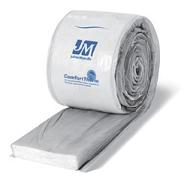Attic Insulation: Reduce Your Home Heating & Cooling Bills
Insulation is installed
in the attic of nearly every home, although a great many homes do not
have enough. In fact, if your home is more than ten years old, there
is a good chance your attic is under-insulated. Heat loss through the
attic has a dramatic impact on home heating costs, especially when you
consider that most families spend 50% to 70% of their utility dollars
on home heating and cooling.

Image Courtesy of Johns-Manville
Insulation
resists the flow of heat and that means with proper insulation, heat stays inside
during winter and outside during summer. With the potential to reduce
your utility bills by hundreds of dollars every year, ensuring you have
adequate insulation makes financial sense. As an added bonus, if
you improve your home's energy efficiency by insulating, you may qualify
for energy credits on your income taxes.
Do You Have Enough Attic Insulation?
The Department of Energy recommends insulating attic space
to an R-value of between 38 and 49 depending upon where you live. Many
homes have fiberglass insulation installed just between the ceiling joists,
providing only about R-18. Attics insulated with fiberglass batts
need roughly between 12 to 16 inches of insulation. If your attic is
under-insulated, you can simply add to your existing insulation to bring
it up the recommended R-value.
How do you determine if you have enough insulation? First,
measure your attic's insulation depth in inches. Next, determine what
type of insulation is installed. Use the table below to find
the R-value per inch and multiple the R-value by the number of inches
you measured. If your R-value is less than the DoE recommended levels,
your home could benefit from added insulation.
Insulation type |
Average R-value
per inch of thickness |
| Fiber glass blanket or batt |
3.2 |
| High performance fiber glass blanket or batt |
3.8 |
| Loose-fill fiber glass |
2.5 |
| Loose-fill rock wool |
2.8 |
| Loose-fill cellulose |
3.5 |
| Perlite or vermiculite |
2.7 |
| Expanded polystyrene board |
3.8 |
| Extruded polystyrene board |
4.8 |
| Polyisocyanurate board, unfaced |
5.8 |
| Polyisocyanurate board, foil-faced |
7.0 |
| Spray polyurethane foam |
5.9 |
What Type of Insulation Should I Use?
Fiberglass is widely used and fairly easy to install. It
comes in loose fill, rolls and batts. The advantage of loose fill is
that it is excellent for filling in nooks and crannies or locations that
are hard to access. Loose fill requires the use of blower equipment,
and while a do-it-yourselfer can install it, you will probably want to
hire a pro.
Batts are the same insulation found
in rolls except that it has already been pre-cut to lengths for use
in walls. Fiberglass rolls are the right choice for most attic space.
The advantage of fiberglass rolls is that they are easy for a DIYer to
install and they require a little less thickness than loose fill. If
you already have insulation in your attic, then use unfaced fiberglass
rolls.
Attic Insulation Installation Tips
- The rolls can be unrolled over the top of the existing
insulation. In fact, you can unroll it perpendicular to the ceiling
joists and you will help to insulate the heat loss through the joists
too.
- Don't add faced insulation to existing insulation because it can
lead to the accumulation of moisture. Instead, use unfaced insulation.
- Your attic requires ventilation. The DoE recommends 1 square foot
of free vent for every 150 sq ft of space with unfaced insulation or
300 sq ft of space with faced insulation.
- Generally, faced insulation should face the interior of your home
if you live in a cold or moderate climate and should face out in hot,
humid climates.
- Recessed light fixtures must be rated for contact with insulation,
otherwise the insulation must be kept well away to prevent a fire.
- Don't forget to cover the attic access hatch, this is a major point
of heat loss in your home.
|
|

|

